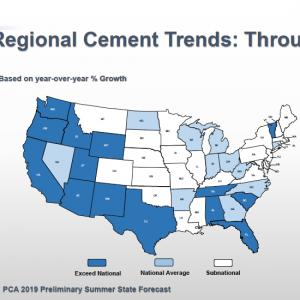At World of Concrete in Las Vegas, Ed Sullivan, executive vice president and chief economist for the Portland Cement Association, noted that the state of the economy is good. Sullivan’s presentation is one of the highlights of the show each year.
 He is predicting cement production increases of 2.6 percent,1.6 percent, 0.8 percent, 1.8 percent and 2.1 percent from 2019 to 2023.
He is predicting cement production increases of 2.6 percent,1.6 percent, 0.8 percent, 1.8 percent and 2.1 percent from 2019 to 2023.
- He is predicting construction spending increases of 2.2 percent, 1.5 percent, 0.9 percent, 1.1 percent and 1.3 percent from 2019 to 2023.
While discussing the state of the economy, Sullivan pointed to these factors as positives:
- Sustained strong job creation and low unemployment rates.
- Wage gains compounded by tax cuts.
- Increase in home values generates wealth gains.
- Household debt burdens are low and credit quality is strong, leading to easier access to credit.
- Interest and inflation rates rise, but slowly and well below historical norms.
- Willing and able consumers. Business taxes may add strength to investment.
“All this will take time to unravel under normal cyclical conditions,” Sullivan said.
In the private sector, Sullivan noted that labor shortages persist. Inflationary pressures are rising, in part due to U.S. fiscal policies. “The Federal Reserve will continue to raise interest rates,” Sullivan said.
Another trend to watch: prices are rising. Interest rates are also rising. Housing affordability is deteriorating. This will slowly erode residential cement consumption, according to Sullivan.
There is also growing concern regarding Collateralized Loan Obligations ($1 trillion) and erosion in credit quality. This concern could slow credit.
In the public sector, Sullivan pointed to simulative “fiscal” policy, which when unemployment is so low, could add stress to labor markets (tax reform, immigration policy, trade friction, infrastructure spending).
He also noted these factors to watch closely:
- Tariffs at a minimum create economic uncertainty.
- Strong job creation, increases state revenues. Entitlement spending has forced state expenditures to rise even faster. Deficits are emerging and are reducing state construction spending – even during good times. As job growth slows, deficits will increase and so will construction cutbacks.
- Federal deficits will exceed $1 trillion annually by 2020 presidential election.
- The possibility of Federal Sequestration emerges in 2020 and represents GDP growth risks.
- A Trump Infrastructure plan may be late to the rescue and smaller than expected.

